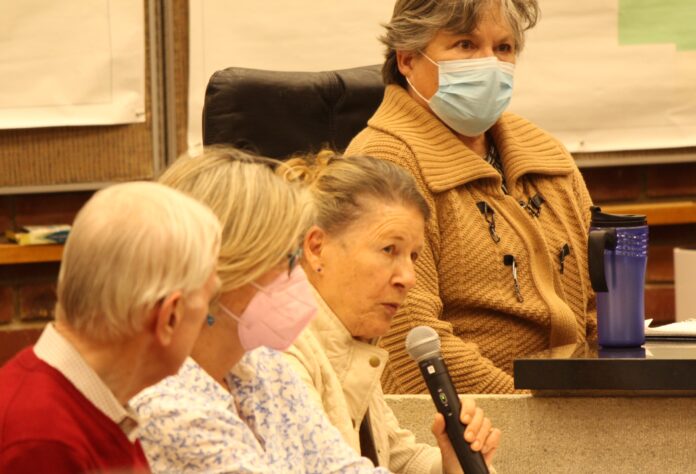
In January, during one of the storm systems, an unhoused resident was found 15 feet up a tree, Ed Lozowicki, a charity worker with the St. Vincent de Paul St. Mary outreach program, told the Los Gatos Town Council on April 4.
“He was there for 10 hours, protecting his kittens, his pets,” he said. “He couldn’t get down.”
As he spoke on Councilmember Rob Moore’s proposal to allocate tens of thousands more dollars towards services for Los Gatos’ most vulnerable residents, a giant tree trunk still rested horizontally on the camp of another homeless person, who luckily no longer inhabited that particular site when it fell.
These realities underscore the feeling faith community representatives brought to the table as they advocated for more cash beyond the original $25,000 of about $1 million in American Rescue Act Plan pandemic-recovery money Los Gatos had left over (after the Town spent $80,000 on Thursday Promenades in 2021 and $120,000 on the street parties in 2022, and the $100,000 more it gave public access broadcaster KCAT just weeks earlier—among other priorities).
Lozowicki made the point that these aren’t, for the most part, drifters of no fixed address coming to Los Gatos for a hand-out, but often are people who grew up in Los Gatos and attended Los Gatos High School.
“They are not transients,” he said. “Many of them have mental health issues or are physically disabled. So, they really rely on the charity of others.”
The plan put forward by Moore called for 24/7 public restrooms, increasing the availability of showers and a voucher program as a way to provide shelter for people without a roof over their heads during natural disasters or other emergency situations—paid for with an additional $75,000 contribution.
Just weeks earlier, after extensive deliberations, Los Gatos had chosen to make combatting homelessness one of its strategic priorities.
Councilmember Matthew Hudes asked the panel about its prior experience with handing out vouchers for temporary housing.
The question made Lozowicki think of the person they’d helped get a hotel room, in January, after he was attacked in his tent in the middle of the night while sleeping.
“He was black and blue all over,” he said. “His eye was shut.”

Although, he said, in that case, they negotiated a cheaper rate with the hospitality firm and paid for it—along with three meals a day—directly, not through a voucher system.
When Vice Mayor Mary Badame learned that only eight to 12 residents—of the 16-18 or so total resident homeless in Los Gatos—seem to use the current shower program, it made her wonder if half of them were choosing to reject the offer of hygiene services.
Marna Taylor, who operates the Los Gatos United Methodist Church’s Shower Ministry, said some of the older residents have access to local gyms through Medicare and that others may be able to shower in others’ homes sometimes.
“There are very few that don’t shower at all in any capacity,” she said.
Badame asked about how the public toilets would stay clean.
Lozowicki said a contractor could be hired to clean them out every 2-3 weeks.
Mayor Maria Ristow wondered whether service providers might be prevented from putting homeless individuals up in hotels if the establishments already had no vacancy or if their customers complained about having to stay alongside the unhoused.
The faith community reps said it would be unlikely all 16-18 homeless people would need shelter during a disaster, as many have emergency-only places they can go and said they would negotiate a discounted room rate with multiple hotels.
Speaking during public comment, Jeffrey Suzuki, of the Los Gatos Anti-Racism Coalition, said spending hundreds of thousands of dollars on a TV station while having only put $25,000 into homeless services sends a powerful message about the community’s priorities.
Chris Wiley, a Los Gatos resident, had sent an email to Council the prior evening expressing her fear that if the community spends $100,000 of ARPA money on homeless services it might not be well spent.
“My suggestion is that before we decide to contribute taxpayer’s money to the homeless problem, we should find out first what the County is doing for us,” she said, pointing to the possibility that Councilmember Moore could hold meetings with various agencies to see what support they could offer. “Possibly, after Mr. Moore (has) exhausted all these sources, he may come back and talk with the Town of how they can add to the mix.”
She noted that a private fundraising drive for the family of a woman killed by a hit-and-run driver in Los Gatos raised more than $100,000 quite quickly.
RJ Fisher Middle School student Dexter Torres wrote to the mayor, as part of an English project, about what to do to combat homelessness in town.
“I propose we make an area with small houses that people could live in for free, but as a requirement you would have to get a job,” Torres pitched. “We can also set up cameras and other systems to make sure the housing area is safe.”
Moore, who previously helped operate a shelter program at the Santa Clara County Fairgrounds, said the voucher system makes more sense than a congregate shelter because those can be dangerous spaces, particularly for women.
Badame said $100,000 is far beyond what Los Gatos can afford to contribute towards the homelessness crisis.
“We can’t fix this as a Town. We certainly care,” she said. “But this is a regional—if not State—issue that’s going to take billions of dollars to fix.”
Moore said he believes the vouchers should be paid directly from nonprofit groups to hotels and noted they could be used not just during winter storms but also during summer fires.
Ristow said getting public restrooms will not only help the unhoused but also tourists and business owners, who currently bear the burden of the lack of such facilities downtown.
Councilmember Rob Rennie was originally skeptical about the voucher idea, thinking it could deplete the money the Town has to spend on homelessness quite quickly.
But in the end he came up with a compromise motion between Badame’s refusal to support any additional money to help homeless residents to Moore’s six-figure proposed total amount.
He offered that Los Gatos could double the original figure to $50,000, which would allow $30,000 for the restroom and shower program, leaving $20,000 for vouchers.
Moore pushed back on this, calculating that if you assume 10 people will need vouchers over the course of the year, that means each could only be housed for about a week.
He compared that to the more than $10,000 the Town spent per participant in the KCAT program, though he said he supports that endeavor, too.
But Rennie wasn’t swayed by this line of argument.
Councilmember Hudes said he agreed that the Town should spend more than the original $25,000 on homelessness, but said he had concerns about nonprofits being deputized to run an untested voucher program.
When Rennie’s motion went to the floor for a vote it was worded in such a way that the money for homeless services would be allocated right away, but that staff would have to come back with a more fleshed-out plan for it to get spent.
The motion passed 4-1, with Badame in opposition.
Jo Greiner, of St. Luke’s Pantry program, cheered the decision, even if it wasn’t as much as they’d originally hoped for.
“I’m excited about it,” she said of the $25,000 that had been added to the pot, minutes earlier. “I think we’ve really made progress here.”
And she said she’s glad Council didn’t go in the direction of finding ways to ship homeless people out to other shelters around the County in a disaster, which had come up as an option.
“That’s exactly what our unhoused community doesn’t want,” she said. “They want to be here. This is their community.”









